Elaine Banks | Radio Producer, DJ, and Screenprinter
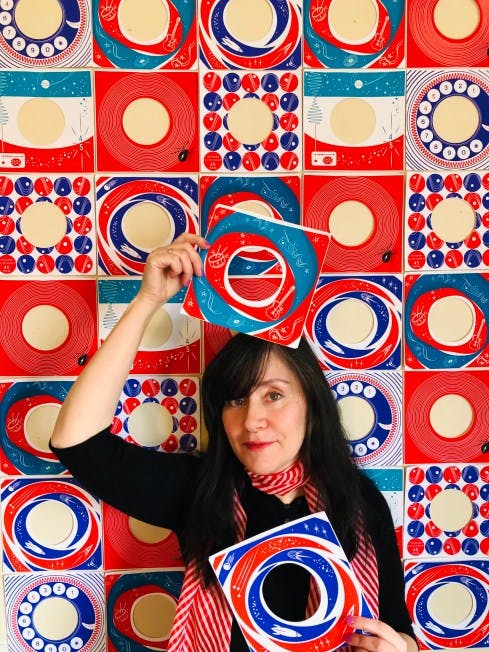
This week we’re featuring a colorful and less discussed part of the process, but one close to my heart, as my background is also in textile / surface design. We love to see someone taking a part of the process that is often taken for granted, those plain white paper 45 sleeves, and making them into something beautiful. We were introduced to Elaine through DJ Cher a Toronto based DJ who you’ll meet next week. Thank you to this community for continuing to share and lift up other Women’s work.
Meet Elaine Banks, a some-time radio producer and DJ, and full-time screen-printer. She’s originally from Toronto, Ontario in Canada, currently residing in Dayton, Ohio where she is producing a line of custom 45 rpm record sleeves at her home studio. From art school to radio and DJing it makes perfect sense for Elaine to have found her way to making our 45s have a more eclectic and appreciated home vs sleeve: generic we see all the time on Discogs.
Before she began printing sleeves, she was into latch hooking (a rug making technique) that was popularized again for awhile, making a series of album cover rugs (DEVO, Alice Cooper, Big Star, Radio Birdman, etc.) which she was selling for a time. She also says: “I love plants and gardening, indoors and outside. I’m helping a local business design their garden this year and I’m very excited about it. I’m into traveling and I prefer exploring cities to hanging out on the beach. This is my third time living abroad (previously London and Amsterdam) so I like to check out new environments.” She collects mid-century ceramics and textiles, loves to cook and listen to records, “I’ve been a vegetarian for over 20 years.” And when all is said and done she enjoys ‘60s horror movies, kicking back with her husband Joe, and their 21-year-old cat Rudy, as well as their newest recruit Astro the Night Cat.
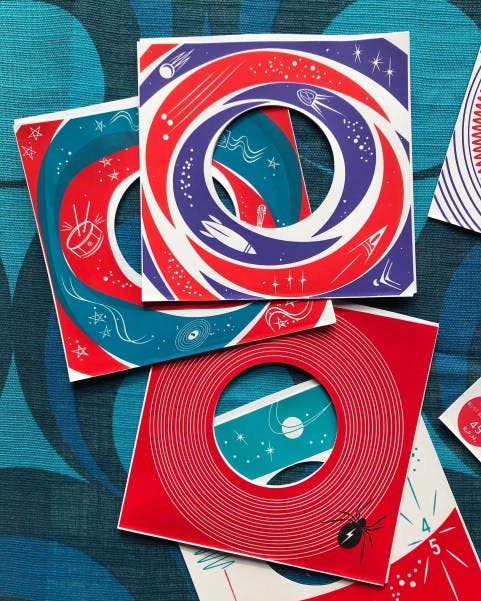
How did you get into your industry / What motivated you to get into it?
I learned screenprinting in 2000 at the Ontario College of Art and Design in a textiles surface design class. I loved it so much, I got special permission to take the class again the following semester. I also did a residency that summer and had full-time access to the OCAD textile studio where I was able to experiment and practice. It was a special time because I never could have done work on that scale in my apartment, and I developed an interest in exploring the possibilities of the medium.
In the years before and after OCAD, I was involved in community radio where I worked in fundraising and promotions. A couple of months into my first job, at CKLN FM, one of the regular show hosts, Lori Beckstead, invited me to fill in on her show and that’s how I got my foot in the door. It was scary at first but as someone who was never extremely social it was a way to communicate with people and to get involved in music in a way that was comfortable and fun for me.
I finally got my own show on CIUT FM a couple of years later. It was called Not of this Earth after the Roger Corman movie, and I spent Tuesday afternoons playing punk, garage, and rock ‘n’ roll records for about three years. I returned to CIUT in 2003 to host a vintage soul and R&B show called Pass the Dynamite with my friend Serge Cassano and that kept me busy for a few years. In between those gigs, I did a one-time show on a pirate radio station in Amsterdam. Through doing radio shows, I became more serious about collecting records. Especially when I got heavy into soul, I wanted to buy everything I could get my hands on and I had to supply all the music for my shows. As an extension of radio, I got into DJing and over the years I’ve played at bars, community centres, squats, house parties, BBQs, union halls, and retail stores.
I started screenprinting custom 45 sleeves in 2017. I’m a big fan of (especially) ‘50s and ‘60s company sleeves and the great design that people could do in a very small space with just one or two colours. Most of the 45s I had were in boring plain white sleeves and I had some old printing supplies that I needed to use up, so I took a stab at designing and printing some custom DJ sleeves. At first it was just a lark to make something fun for me and my friends Christina Wozniak, Tara Bursey, and Cindy Wolfe who are also collectors, DJs, and artists. I made a different sleeve design for each of us with our names on them. When I posted pictures, people seemed keen on the idea, so I thought, why don’t I make a line of screenprinted sleeves that anyone can buy and enjoy? I looked around and no one was doing that, so I thought – here’s a good opportunity to do something original and interesting with screenprinting and music. Since moving to Dayton, I’m in a situation where I can devote more time and space to printing larger quantities and they’re getting around! I’m happy to offer something unique that’s stylish, useful, and affordable and my sleeves are now in record collections around the world, which is amazing to me.
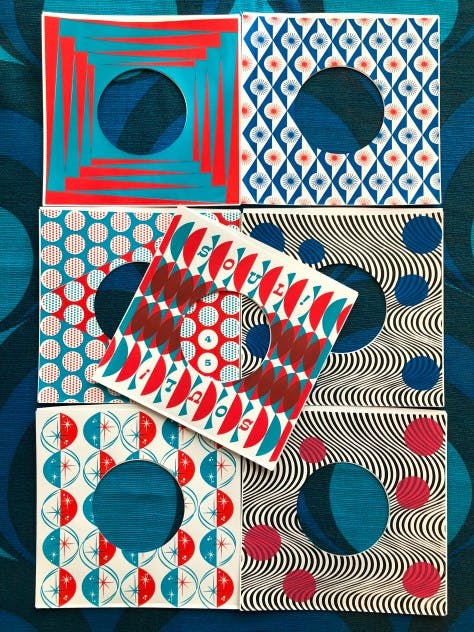
What is a day in the life like?
Make coffee, feed and water the cats. That’s where the routine ends! Because I’m a one-person operation, I’m responsible for every aspect of the business and I have to deal with different things depending on where I am in the process. That can be ordering supplies, taking orders, packaging orders, making post office runs, bookkeeping, photographing my work, and promoting it, sketching and designing new ideas. I’m also the receptionist so I answer inquiries about ordering, custom work, commissions, etc.
When I’m actively printing, I like to keep as regular hours as possible. I aim to be in the studio by 10 a.m. and finish by around 6 p.m. I really prefer working by natural light, so in the spring and summer, if I’m feeling it, sometimes I’ll crack on into overtime. Since I work in my house and I don’t have that physical boundary between work and home life, a normal schedule helps keep my work time blocked off from my personal time. I try not to work on weekends unless it’s to do something time sensitive like sending out orders. I really enjoy what I do, and I’d hate for that to change, so I’m cautious about burnout.
In your opinion what has been your favorite / the coolest thing you’ve worked on?
When I left community radio in 2008, I pitched a documentary to CBC Radio on soul artist, Jackie Shane (see below). I didn’t know the first thing about documentary production, but I really wanted to know more about Jackie, an artist I’d played on my show a bunch of times but could find almost no information on. I got the green light to do the doc, and spent the next two years interviewing, digging in archives, pulling together every bit of information I could find, including discovering some of her unreleased material in Library and Archives Canada. When that documentary was released, it set off widespread curiosity about Jackie and renewed interest in her life and music. Years later, and shortly before she passed away, Jackie invited me to interview her on CBC. She shared some stories from her life and we talked about the documentary as the spark that led to her being located after living privately for many years, and to her music being rereleased, and what all that meant to her. It was not only Jackie’s first radio interview, it was also the first time we had spoken to each other, so it was a very exciting and emotional experience. Readers can hear that very candid interview here.
I also think one of the coolest things I’ve ever done is what I’m doing right now! I’ve had office jobs for most of my life, and I’ve worked for some great (mostly non-profit) organizations doing satisfying, rewarding things (I won a design award in 2019 for my work on a union magazine). But sitting at a desk all day, five days a week, with a long commute on either end, just to get by, wasn’t the healthiest thing for me. I felt like my ideas were always piling up and I never had any time to work on them. Add to all that, I’ve always had trouble conforming and I hate routine. I like the ownership I have over what I’m doing now. I can work hard at it, it’s physically varied and it’s adaptable – I can take it in new directions, or I can work other interests around it.
What has been / is the most difficult part of your job?
The best part is also the most difficult part: being my own boss! Unfortunately, I’m the most lenient boss in history, so I really need to remind myself to act like I’m employed. Like what would be expected of me on a job? So, I’m getting used to that and trying to be more disciplined, keeping regular hours as I mentioned. Because I’m a one-woman operation I’m responsible for a couple of things that I’m not crazy about but can’t escape – like (self) promotion and pricing my work! That’s a big one. It’s hard to strike the balance of being paid fairly and keeping prices reasonable. A component of that is sharing information on the process so people understand it and see that it’s necessarily more expensive than something that’s mechanically printed. Most people get it. I’m working on getting my stuff into retail stores right now so that’s a whole other pricing challenge, but I’ll get there. I’m trying hard to improve my weaknesses while not being hard on myself and learning as much as possible.
What advice do you have for someone wanting to get into pursuing what you’re doing?
Get formal training in graphic design, surface design, and screenprinting. I break rules and use unorthodox methods all the time because I found what works best for me. Because I learned the ‘right way’ to do things, when something goes wrong, I know why and how to fix it. It’s way less stressful, you’ll save a lot of time and money and you’re more likely to stick with it. You don’t have to do a four-year degree or anything like that if you don’t want to. See what’s offered at your local college or look for print collectives in your area that offer short courses or workshops. Everyone learns differently, but it can be helpful to have someone in the room with you to help you through your first steps. If none of that is an option, there are tons of online tutorials that you can access and go at your own pace. Keep in mind: screenprinting looks super easy, but it takes a lot of trial and error to get good at it – there are so many variables involved in making a good print, so don’t get discouraged. If you keep learning and practicing, you will get good at it!
For DJing or radio work – don’t be afraid put your ideas out there. If you want to get involved, reach out to people, introduce yourself, see if you can volunteer at a community station, or approach a venue about DJing. If you have records that you love and want to share, and you know how to operate a turntable, you’re qualified.
Are you a vinyl collector yourself? What drew you to it?
I’ve always liked music and I grew up with vinyl records so they’re just a normal to me. I have purchased CDs in the past, but I could never really get into them. They just seemed cheap with those plastic jewel cases that were always breaking, and the music never sounded as good as on vinyl. Same with digital music files. The lack of substance was always a letdown, too. I just like the physical part of records. I have a deep interest in music history as working-class history, so liner notes, artwork, photos, and even stuff like record store stamps, signed names, and items stuffed inside records serve as important historical documents. As a designer, a record collection provides endless nice artwork, layout and typography inspiration across art and design movements.
That’s a long way of saying – yes, I’m a vinyl collector by way of being a music, history, and art lover.
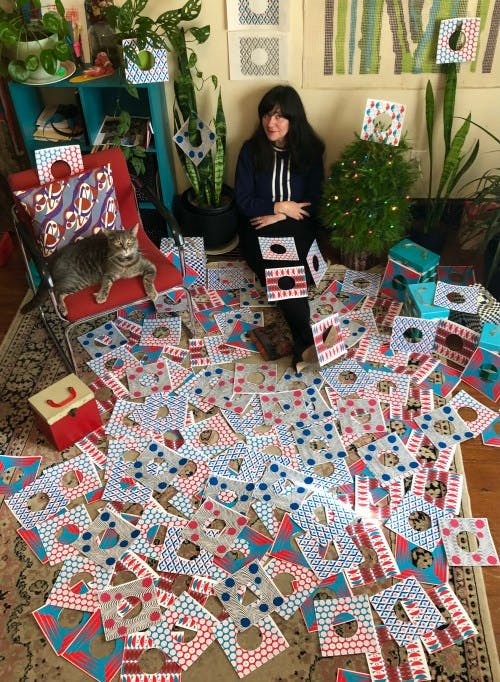
What types of things are happening in your industry / with vinyl that you’re excited or worried about?
I’m amazed by the amount of hard work that goes into finding and releasing under appreciated artists, and rare or unreleased material from the past. On the upside, thanks to a tremendous amount of knowledge and dedication, recordings are saved that might otherwise get trashed or forgotten. These projects are usually driven by a genuine love and appreciation of the music, and there’s an important historical preservation aspect to this as well.
I would like to see more transparency relating to “rediscovered” artists being paid proper royalties. I wonder about permissions and whether royalties are being paid at all, especially when the releases don’t involve the artist or their family members. Shady bootleggers aside, people who have very little or nothing to do with an artist’s work, including at times the labels themselves, sometimes end up with ownership of other people’s material.
Related to this is the seemingly arbitrary, astronomical pricing of certain records in the resale market across genres but especially in the soul collecting market. Original records by (mostly) black artists are bought and sold for sometimes thousands of dollars by (mostly) white people. These are artists who in many cases never made royalties, had their rights stolen, were exploited in so many ways and now that their work has become this hot commodity, they’re still not able to profit from it, while others do. Only people with tons of cash can afford to own these rare original copies while people who have no rights to the music make a killing. Something needs to happen to make sure artists, or their families, get residuals from the insane money that people are getting for these records. I don’t think donating to charities unrelated to the artist (something that’s been suggested) is the answer.
These are nuanced problems that exist within the overwhelmingly good and positive work that people are doing, but they’re significant. I’d like to see much more discussion around these issues.
During this time we’re currently in, what message do you have for music and vinyl fans? How can we support you, the industry?
Be democratic in your enjoyment and sharing of music and buy music that you like or are curious about. Don’t feel pressured into buying expensive original presses, Record Store Day releases, what a certain scene dictates or get hyper fixated on LPs vs 45s or whatever. To each their own, but I’m put off by the vinyl lifestyle and “vinyl influencer” trend on social media that reinterprets records as middle-class status symbols where the music seems to come dead last.
You don’t need a ton of money to be a collector and you’ve got nothing to prove while doing it – it’s not a contest. Check out dollar bins and take chances on stuff that just looks interesting even if it’s outside of your favourite genre, split seams and all. You’ll be pleasantly surprised, you’ll be let down, you’ll have a good laugh, you might discover your new favourite band. It’s music – relax and enjoy it on your own terms.
In terms of support, I’ve been very lucky so far! For the most part, I’ve been able to get my ideas out there and have found receptive audiences. So, I would just say, keep the door open for women with new ideas and respect those ideas (don’t steal them), encourage women in their pursuits – in all areas of the vinyl industry – and spread the word! Word of mouth and referrals are so helpful (and free), and patronage is crucial.
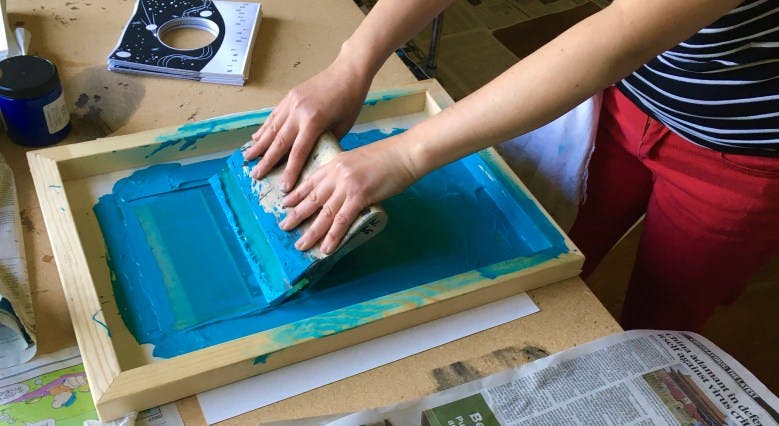
Anything else you want to share?:
I want to thank everyone who’s helped me at any point along the way, either by hiring me, letting me do radio, teaching me how to make art, encouraging me, patiently listening to me sound off about all kinds of ideas, or just setting good examples for me to follow. We all build on the hard work of others and it’s important to acknowledge that.
I’d also like to thank Toronto’s DJ Cher for nominating me for this feature, and Women in Vinyl for interviewing me. I appreciate it very much!
Find Elaine:
Instagram: @elaineprints
We hope you enjoyed this content! If so inclined please donate so we can continue bringing you more like this. There is no amount too small.

